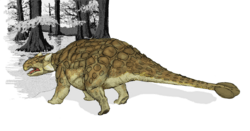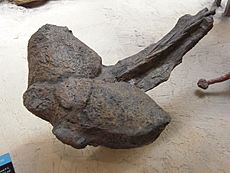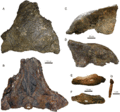Ankylosaurus facts for kids
Quick facts for kids AnkylosaurusTemporal range: Upper Cretaceous
80 to 66 mya |
|
|---|---|
 |
|
| Scientific classification | |
| Kingdom: | |
| Class: | |
| Superorder: | |
| Order: | |
| Suborder: | |
| Infraorder: | |
| Family: | |
| Tribe: |
Ankylosaurini
|
| Genus: |
Ankylosaurus
|
| Binomial name | |
| Ankylosaurus magniventris |
|
Ankylosaurus (Ankylosaurus magniventris) was a type of armoured dinosaur. It was the largest of its type, with a maximum length of 9 metres (30 feet).
The body was broad and low-slung and covered in armour. Carnivores, attacking from above, would find no weak points, and the animal could defend itself by using its clubbed tail.
Ankylosaurus was a herbivore, or plant-eater. Because there was no grass in the dinosaur times, the Ankylosaurus probably ate ferns and low shrubs.
Armour
The most obvious feature of Ankylosaurus is its armour, consisting of massive knobs and plates of bone, known as osteoderms or bony scutes, embedded in the skin. Osteoderms are also found in the skin of crocodiles, armadillos and some lizards. The bone was probably overlain by a tough, horny layer of keratin.
These osteoderms ranged greatly in size, from wide, flat plates to small, round nodules. The plates were aligned in regular horizontal rows down the animal's neck, back, and hips, with the many smaller nodules protecting the areas between the large plates. Smaller plates may have been arranged on the limbs and tail. Compared to the slightly more ancient ankylosaurid Euoplocephalus, the plates of Ankylosaurus were smooth in texture, without the high keels found on the armor of the contemporaneous nodosaurid Edmontonia. A row of flat, triangular spikes may have protruded laterally along each side of the tail. Tough, rounded scales protected the top of the skull, while four large pyramidal horns projected outwards from its rear corners.
Underneath it was covered by normal skin, but to get at it the carnivore would have to turn over an animal weighing up to 6,000 kg (11,000 lb).
Images for kids
-
Skull of holotype AMNH 5895 and reconstruction diagram of same
-
1908 skeletal reconstruction of the holotype, with missing parts restored after Stegosaurus
-
Replica of the 1964 World's Fair Ankylosaurus (note spikes and dragging tail), Royal Alberta Museum
-
Cervical half ring from the neck of Euoplocephalus (A–B) compared with half-ring fragments (C–J) of Ankylosaurus (holotype), and possible back osteoderms (K–L)
-
Only known tail club (AMNH 5214), American Museum of Natural History
-
Skull of specimen CMN 8880, the largest-known ankylosaurid, including lower jaw (E–F) and tooth (G)
-
Back vertebra with fused ribs of the holotype. The broad body housed a large digestion system.
See also
 In Spanish: Ankylosaurus magniventris para niños
In Spanish: Ankylosaurus magniventris para niños
















